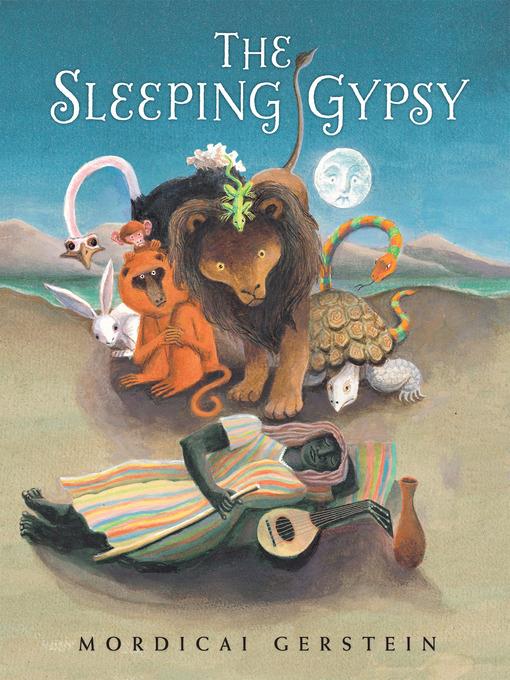
The Sleeping Gypsy
فرمت کتاب
ebook
تاریخ انتشار
2016
Reading Level
2
ATOS
3.7
Interest Level
K-3(LG)
نویسنده
Mordicai Gersteinناشر
Holiday Houseشابک
9780823437429
کتاب های مرتبط
- اطلاعات
- نقد و بررسی
- دیدگاه کاربران
نقد و بررسی

August 22, 2016
Henri Rousseau's painting "The Sleeping Gypsy" has a mysterious charm all its own. Gerstein (I Am Pan!) builds his story around itâand in it. The original painting shows a woman fast asleep in the desert with a lion standing over her. Gerstein rewinds to the start of her journey, showing her walking across the desert, then lying down at nightfall to sleep. Desert animals begin to nose about, and then a lion leaps through the group, ready to eat her. At that moment, a man wearing a beret steps out of the shadows. "I am Henri Rousseau," he says. "We are all in a dream. It is my dream." Setting up his easel, he takes charge: "You, Lion, stay just where you are and lift your tail a bit." When the other animals complain ("You've made my nose too big"), he summarily paints them outâall but the lionâthen repairs to Paris to finish the canvas. Gerstein interprets Rousseau's painting style both faithfully and freely, and his story suggests that there's nothing inevitable about the famous works of art we think we know. Ages 4â8.

Inspired by Rousseau's painting of the same name, Gerstein imagines a dream that provoked the artist to create it.It's unfortunate that a different book title highlighting the dream conceit, rather than reiterating the painting title's problematic use of "gypsy," wasn't used. A prologue includes a black-and-white drawing of a child looking at the painting and explicitly says, "this book suggests some of the answers" to possible questions prompted by the mysterious scene. Although she appears neither childlike nor small, the text refers to the sleeping person as "a girl" and identifies her as a figure in Rousseau's dream. Instead of answering questions that would put her story at the center (Why is she walking through the desert? What is her name? Where is she going?), the text and art introduce animals (including the lion that looms over the figure in the painting) that enter Rousseau's dream and speculate about her. Then Rousseau enters his own dream, announcing that both girl and animals are there "so that I may paint a picture," which reinforces her marginalization. When Rousseau himself awakens, he, of course, paints his dream--minus all the animals but the lion, as they become so contentious he omits them. Gerstein ably captures the dreaminess of both his subject and the story, but although the participation of the animals is a child-friendly device, it serves to distract readers from the unanswered questions about the title character. A whimsical artistic meditation that perhaps needed more time on the drawing board. (Picture book. 5-8) COPYRIGHT(1) Kirkus Reviews, ALL RIGHTS RESERVED.

September 1, 2016
PreS-Gr 2-Henri Rousseau was a self-taught artist who worked in France during the late 19th and early 20th centuries. Often referred to as a naive painter, he is known for his lush, fanciful, and mysterious jungle scenes. One of his most haunting canvases, The Sleeping Gypsy, exhibits these characteristics but is set in the desert; a woman in a striped caftan lies asleep in the sand under a moonlit sky, a mandolin and a jug of water by her side, as a lion peers into her face. Here, Gerstein imagines a story about this painting; Rousseau dreams that he walks into the desert, sets up his equipment, and begins limning the menagerie of animals gathered around a slumbering woman, curious to know what she is doing, where she is headed, and what she is seeking. But one by one the artist erases the animals from his canvas when they comment negatively on his portrayals, until only the lion is left, guarding the figure as the morning sun rises. In reproducing the artist's dream, Gerstein evokes the same surrealistic nature of the painting, but his pesky animals lighten the tone (though this lion does bare his teeth). Like Samantha Friedman's What Degas Saw and Susan Goldman Rubin's Roy's House, this title offers children a story and information about an important Western artist and his work. VERDICT For large collections and anywhere books on art and artists are enjoyed and needed.-Daryl Grabarek, School Library Journal
Copyright 2016 School Library Journal, LLC Used with permission.

September 15, 2016
Grades K-3 An African girl wearing a striped robe strides across the desert carrying a clay bottle of water, a satchel of food, and a mandolin. At night she eats, plays a song, and falls asleep on the sand. While she slumbers, a group of animals gather around to investigate. When an artist (Henri Rousseau) arrives to paint the scene, all the animals except the lion critique his work, causing the artist to remove them from the scene. In the morning, Rousseau awakens in Paris, ready to finish his masterpiece, which he titles The Sleeping Gypsy. Rousseau's mysterious work has long intrigued critics and viewers, and Gerstein isn't the first to suggest it has dreamlike qualities. The Caldecott winner's acrylic-and-digital artwork pays homage to Rousseau with eerie and meditative spreads. The animals appear in vibrant colors that echo the stripes in the girl's robe, and Gerstein's moon has an expressive (and changing) face that reflects the story's action. Pair with Michelle Markel's The Fantastic Jungles of Henri Rousseau (2012) for another take on this iconic artist.(Reprinted with permission of Booklist, copyright 2016, American Library Association.)

























دیدگاه کاربران